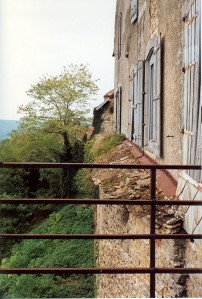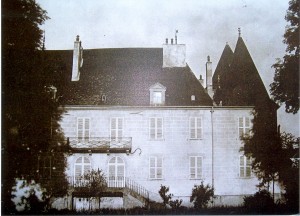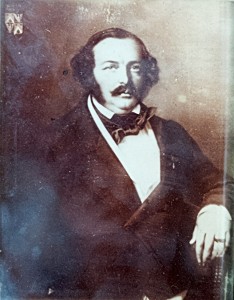The invention of the ‘lead’ pencil is credited to the English in 1564. The inventor of the pencil sharpener was a Frenchman, Thierry des Estivaux. At Paris in 1847, he patented his design of the classic tube fitted with a narrowing cone and a blade. It was an invention that saved the fingers of generations of schoolchildren, who would otherwise have had to whittle the points of their pencils with their pocket-knives. It is an object that is universal and taken for granted.
Constant de Thierry des Estivaux was a gallant officer and patriot. He was born at Paris in 1797, the eldest son of Colonel Gaspard de Thierry, Baron des Estivaux in Lorraine, the dashing commander of the 9th Hussars during the Wars of the Revolution, and his beautiful wife Romarine, Comtesse de Faletans et Digoine, a franc-comtoise.
In 1814, while still a schoolboy, Constant took part in the defence of Besançon, and in 1815, aged 17, fought beside his father at the Battle of Waterloo, where he five times wounded. He served in the Besançon Dragoons and, from 1822, in the Russian army, as personal aide-de-camp to his ‘uncle’, the General Comte de Langeron. One of the great men of his age, Langeron had saved the life of the ‘grand old’ Duke of York, fought the Turks under Potemkin and commanded a division at Austerlitz. A distant relative, he treated Constant as his own son.
Constant left Russia after Langeron’s death in 1831, intending to settle in Paris. At Briançon, on the French border, he was arrested, apparently on the orders of Adolphe Thiers, the Minister of the Interior. Constant’s baggage, containing Langeron’s voluminous papers, was seized. The documents eventually found their way into the Ministry of Foreign Affairs in Paris, and various parts of them have since been edited and published. Without always acknowledging it, Thiers makes full use of them in his Histoire de l’Empire (published from 1845), which in turn was to provide Tolstoy with much of his background material for War and Peace (published from 1868). Langeron’s account of Weyrother’s briefing before the Battle of Austerlitz forms the basis of a particularly memorable scene (Book III, Chapter XI). Tolstoy has him toying with a gold snuffbox whilst he listens to Weyrother’s nonsense, an ironical smile on his face as he attempts to sting his vanity. Langeron, to whom Byron had already referred flatteringly in verse in Don Juan, would not have been displeased.
 As far as is known, Constant was never again to be formally employed. Instead, he tried his hand as an inventor. In 1839 he took out a patent in England for one of his inventions, for some reason using the pseudonym ‘Morillon’. On 21 April 1846 he took out another patent, this time in France, for his design of a ‘palmiped propeller suitable for coastal and inland navigation’. His attempt at improved propulsion recalls the ‘pyroscaphe’, the pioneering steam-powered paddle propeller invented by his older relative, the Marquis de Jouffroy d’Abbans, and tested on the Doubs at Beaume-les-Dames in 1776. In retirement at the Château d’Abbans-Dessus (Doubs) – pictured left – from 1816, Jouffroy d’Abbans had been a near neighbour of the Faletans (who had retreated during troubled times to their own château at Busy), perhaps passing on his passion for engineering to the young Constant. Jouffroy d’Abbans had received little reward or recognition for his invention, and had died, a needy pensioner in the Hôtel des Invalides, in July 1832. If not positively ruined by his efforts, Constant, likewise, was hardly enriched by them.
As far as is known, Constant was never again to be formally employed. Instead, he tried his hand as an inventor. In 1839 he took out a patent in England for one of his inventions, for some reason using the pseudonym ‘Morillon’. On 21 April 1846 he took out another patent, this time in France, for his design of a ‘palmiped propeller suitable for coastal and inland navigation’. His attempt at improved propulsion recalls the ‘pyroscaphe’, the pioneering steam-powered paddle propeller invented by his older relative, the Marquis de Jouffroy d’Abbans, and tested on the Doubs at Beaume-les-Dames in 1776. In retirement at the Château d’Abbans-Dessus (Doubs) – pictured left – from 1816, Jouffroy d’Abbans had been a near neighbour of the Faletans (who had retreated during troubled times to their own château at Busy), perhaps passing on his passion for engineering to the young Constant. Jouffroy d’Abbans had received little reward or recognition for his invention, and had died, a needy pensioner in the Hôtel des Invalides, in July 1832. If not positively ruined by his efforts, Constant, likewise, was hardly enriched by them.
 Constant de Thierry des Estivaux adopted the surname ‘de Thierry de Faletans’ in 1848 and in 1860, having settled at the Château de Faletans (Jura) – pictured left – was recognised as Marquis de Faletans, a title inherited from his uncle. He was my great-great-great-grandfather. Until recently, I had no idea that he had invented the pencil sharpener. This was surely Constant’s proudest achievement but, unfortunately, is not the basis of any family fortune. The mass production of pencils dates from the later 19th century. The huge and continuing demand for pencil sharpeners, for use in schools and offices, took off in the early 1900s. Constant had died in 1871. He deserves to be better known.
Constant de Thierry des Estivaux adopted the surname ‘de Thierry de Faletans’ in 1848 and in 1860, having settled at the Château de Faletans (Jura) – pictured left – was recognised as Marquis de Faletans, a title inherited from his uncle. He was my great-great-great-grandfather. Until recently, I had no idea that he had invented the pencil sharpener. This was surely Constant’s proudest achievement but, unfortunately, is not the basis of any family fortune. The mass production of pencils dates from the later 19th century. The huge and continuing demand for pencil sharpeners, for use in schools and offices, took off in the early 1900s. Constant had died in 1871. He deserves to be better known.
See http://fr.wikipedia.org/wiki/Taille-crayon
and

Trackbacks /
Pingbacks